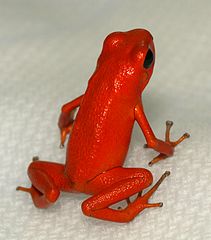 Recently I posted an article about native treefrogs in my own collection: My Animal Collection: How a Herpetologist Keeps Barking Treefrogs (Hyla gratiosa) and Gray Treefrogs (Hyla versicolor). Today I’d like to add some thoughts on another US native, the very attractive green treefrog. Please see my earlier article for detailed information on treefrog care.The green treefrog is so often collected for the pet trade, and so inexpensive, that many here take it for granted. It is, however, one of the most beautifully colored of the word’s Hylids, and much favored by hobbyists in other countries.
Recently I posted an article about native treefrogs in my own collection: My Animal Collection: How a Herpetologist Keeps Barking Treefrogs (Hyla gratiosa) and Gray Treefrogs (Hyla versicolor). Today I’d like to add some thoughts on another US native, the very attractive green treefrog. Please see my earlier article for detailed information on treefrog care.The green treefrog is so often collected for the pet trade, and so inexpensive, that many here take it for granted. It is, however, one of the most beautifully colored of the word’s Hylids, and much favored by hobbyists in other countries.
Feeding Tips
Green treefrogs top out at 2 ½ inches in length, and are slender in build. I’ve found that they do best when given only small insects, the size of a ¼ to ½ inch cricket, despite their willingness to tackle larger prey. I suggest that you avoid adult crickets, large waxworms and the like, as they may be too much for this species’ digestive system to handle on a regular basis.
Perhaps due to their arboreal nature, these frogs react very strongly to flying insects. The feeding response is quite dramatic when I offer them moths and small flies, and noticeably different than their reaction to crickets and waxworms. Small wild-caught insects (Zoo Med’s Bug Napper is an excellent trap) should be given regularly. Most green treefrogs feed readily from plastic tongs….canned silkworms are an excellent addition to the diet. These frogs are persistently arboreal, so burrowing insects such as small butterworms and waxworms should be placed in cups suspended from tree branches, or hand-fed.
Green treefrogs are accomplished jumpers, and adept at snatching insects on the wing. At feeding time, a group I housed in the Bronx Zoo regularly stole the show from their somewhat sedentary exhibit mates – a pair of water moccasins!
Captive Breeding
Unfortunately, little attention is given to breeding this spectacular frog in captivity. Males in the zoo group I mentioned began calling in response to increased showers, but the females did not respond with eggs. As most green treefrogs in the trade hail from Florida and Louisiana, a dry period followed by frequent misting and a rise in temperature of 5-10 F might do the trick.
You can learn more about the natural history of the green treefrog at:
http://www.natureserve.org/explorer/servlet/NatureServe?searchName=Hyla+cinerea
 That Reptile Blog – Reptile, Amphibian and Exotic Pet Care and Information
That Reptile Blog – Reptile, Amphibian and Exotic Pet Care and Information



Hello,
I have a question concerning plastic terrariums. As my collection grows, I’m looking for containers that are easy to move and clean. Friend use sweater and plastic boxes but these do not allow one to see the animals so easily. Are any of the plastic tanks with attached tops large enough to keep small reptiles or amphibians, tarantulas, etc permanently? Thanks..
Hello, Frank Indiviglio here. Thanks for your interest in our blog.
A number of plastic terrariums are available in a wide variety of shapes and sizes.all allow clear viewing, are lightweight and can serve as permanent homes for some creatures. I make extensive use of our largest model, the Jumbo Pla House Terrarium. It measures 17” x 11” x 11.5”, and holds 9.2 gallons of water. It is best used for amphibians or reptiles that do not need UVB (i.e. house geckos) and for spiders, scorpions and other invertebrates. I have found it useful as a home for American toads, small green and White’s treefrogs, poison frogs and a wide variety of newts, salamanders and local and exotic invertebrates. A 5 wt. hood light, which fits nicely into the hood, is perfect for illuminating the terrarium. I also have 2 set up as aquariums, housing an Australian crayfish and a fossil catfish. Dive Clean Mini Filters and Small World Filters fit inside nicely, and I use a Mini Aquarium Heater to warm the water.
The Round Pla House Terrarium is vertically oriented and serves well as a home for small to medium sized treefrogs, house geckos and pink-toed and other arboreal spiders.
The terrariums can be set up as you would any other enclosure, but are especially useful as you contemplate – for expanding collections where ease of maintenance is important.
Plastic scratches easier than glass, so take care when adding substrate and cleaning. Scratched or damaged terrariums make secure, well-ventilated enclosures for nutrient loading crickets, mealworms, sow bugs and other food animals.
Best regards, Frank Indiviglio.